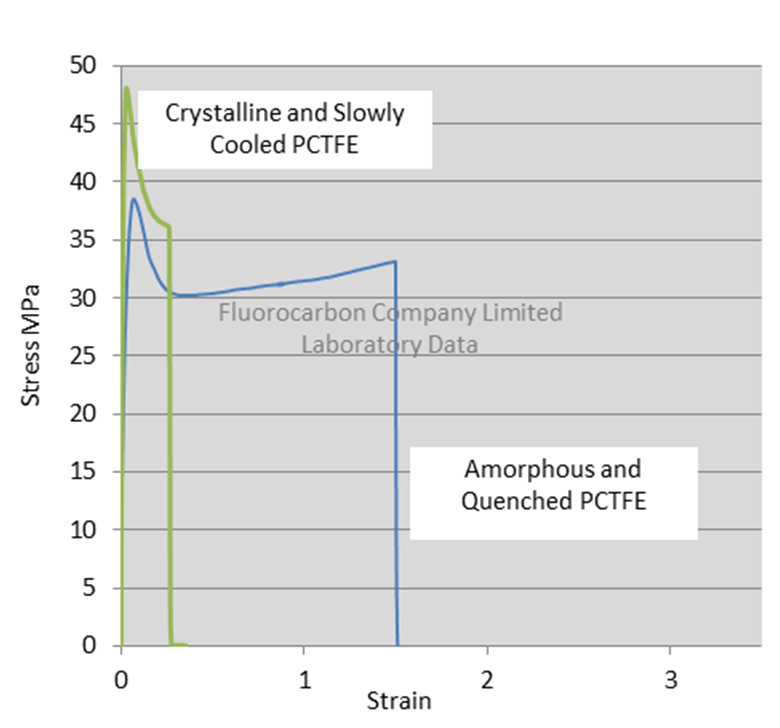What is Polychlorotrifluoroethylene? (PCTFE)
March 2016

Polychlorotrifluoroethylene- Chemical compound (PCTFE)
PCTFE was discovered in 1934 by Fritz Schloffer and Otto Scherer who worked at IG Farben. PCTFE was commercialized under the trade name Kel-F 81 by M K Kellogg in the early 1950’s. This was acquired by 3M in 1957 and manufactured under the brand name of Kel-F® By 1996, the 3M Company had discontinued manufacturing the resin and sold the rights to Daikin Industries Ltd, who now produces the resin under the brand name Neoflon® PCTFE.
The actual Kel-F® product is no longer available in the marketplace but the name is still used widely in the industry, along with PTCFE.
The difference between PTFE and PCTFE is mainly in the chemical structure. Chlorine group was introduced in place of Fluorine and it leads to a massive change in its properties and application. Chlorine atom which is bigger than Fluorine atom breaks the structural regularity affecting crystallisability of polymer chains. This leads to decrease in degree of crystallinity when compared to PTFE. This reduction in structural regularity and crystallisability results lower melting point and makes PCTFE manufacturable as the transparent product in films and thin sheet markets. The presence of Chlorine group instead of Fluorine group not only decreases the crystallisation phenomenon but also increases intermolecular forces leading to PCTFE being a harder and stronger polymer.
PCTFE is a harder and stronger polymer, with better mechanical properties than PTFE. The crytallisability of PCTFE can be altered by controlling cooling in the melt processing operation; this feature is exploited to get wide varieties in properties and applications. With high Crystallinity, PCTFE is dense with high mechanical properties and elongation. Alternatively, when quench cooled, PCTFE is lighter, transparent and more elastic. The quench cooled PCTFE is widely used in cryogenic engineering applications for handling liquid oxygen and liquid nitrogen. Valve seats made of PCTFE are widely used at cryogenic temperatures. The effect is shown in the below mentioned stress strain graph:
Figure: Effect of Crystallinity on mechanical properties of PCTFE

Even though PCTFE has less thermal properties than PFA and PTFE, PCTFE it is widely used because of its better mechanical properties, particularly its hardness lending itself to applications such as impermeable packaging material in military applications and sight glass material in chemical apparatus where other materials cannot be used. PCTFE is widely used in Valves, gaskets and O-Rings as well as some electrical insulation applications. PCTFE doesn’t absorb water and properties such as dimensional stability and electrical insulation don’t get affected in high humidity and marine environments, making it a good alternative in marine applications.
PCTFE is melt processable by conventional process techniques such as Injection moulding, Extrusion and Compression molding. However, processing of PCTFE is not as simple as in other materials and this complexity is due to the following reasons: ZST, Crystallinity and Residual stress. ZST, Zero-strength time, is a measure of molecular weight for PCTFE. The processing techniques normally lead to drop in ZST. Normally compression moulding gives higher ZST product than extrusion and injection moulding product. Higher ZST gives good physical properties and normally measured as described in ASTM D1430.
Crystallinity has a direct effect on its properties and it is generally affected by ZST and rate cooling in the melt processing operation. Residual stress is mainly developed during melt processing operation. The factors that affect residual stress are type of processing operation, exposure to shear and rate of cooling. Generally, compression moulding gives lower residual stress than other operations. Another way to reduce residual stress is to anneal the product at high temperature to relieve the stress. At Fluorocarbon, the processes are designed and optimised by understanding the melt rheological properties of PCTFE to give best ZST, lower residual stress, good machinability and long service.
For more information on our virgin PCTFE FL325, download the datasheet here
To find out how we can support your projects contact info@fluorocarbon.co.uk










